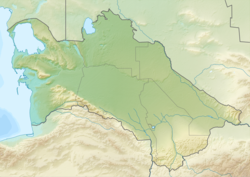




 Innovative Wine Disposal Systems. Visit Old Nisa, a 2nd century BC Parthian Empire fortress. In 2007, this fortress was declared a World Heritage Site by UNESCO. Though Old Nisa is still being excavated, tour the premises and see current renovations taking place. Best to go with a knowledgeable guide like the one I had, a prestigious Turkmen professor of archaeology, whose humor and colorful anecdotes can bring to life the rich past of Old Nisa. Listening to his stories, you can almost taste the red wine that flowed within Nisa’s walls. Did you know that there were actually wine pipes between rooms, so that old wine could be deposited into the kitchen to be used as cooking wine? Genius. (Warning: After the tour, you may want to buy a couple bottles of Turkmen wine.)
Innovative Wine Disposal Systems. Visit Old Nisa, a 2nd century BC Parthian Empire fortress. In 2007, this fortress was declared a World Heritage Site by UNESCO. Though Old Nisa is still being excavated, tour the premises and see current renovations taking place. Best to go with a knowledgeable guide like the one I had, a prestigious Turkmen professor of archaeology, whose humor and colorful anecdotes can bring to life the rich past of Old Nisa. Listening to his stories, you can almost taste the red wine that flowed within Nisa’s walls. Did you know that there were actually wine pipes between rooms, so that old wine could be deposited into the kitchen to be used as cooking wine? Genius. (Warning: After the tour, you may want to buy a couple bottles of Turkmen wine.)
Nisa, Turkmenistan
| Parthian Fortresses of Nisa* | |
|---|---|
| UNESCO World Heritage Site | |
 | |
| State Party | Turkmenistan |
| Type | Cultural |
| Criteria | ii, iii |
| Reference | 1242 |
| Region** | Asia and Australasia |
| Inscription history | |
| Inscription | 2007 (31st Session) |
| * Name as inscribed on World Heritage List. ** Region as classified by UNESCO. | |
Nisa (also Parthaunisa) was an ancient city, located near modern-day Bagir village, 18 km northwest of Ashgabat, Turkmenistan. Nisa is described by some as one of the first capitals of the Parthians. It was traditionally founded by Arsaces I (reigned c. 250 BC–211 BC), and was reputedly the royal necropolis of the Parthian kings, although it has not been established that the fortress at Nisa was either a royal residence nor a mausoleum.
Contents[hide] |
[edit] Excavations


Excavations at Nisa have revealed substantial buildings, mausoleums and shrines, many inscribed documents, and a looted treasury. Many Hellenistic art works have been uncovered, as well as a large number of ivory rhytons, the outer rims (coins) decorated with Iranian subjects or classical mythological scenes.
Nisa was later renamed Mithradatkirt ("fortress of Mithradates") by Mithridates I of Parthia (reigned c. 171 BC–138 BC).
Nisa was totally destroyed by an earthquake, which occurred during the first decade BC.
The fortress at Nisa was declared a World Heritage Site by UNESCO in 2007.[1]









